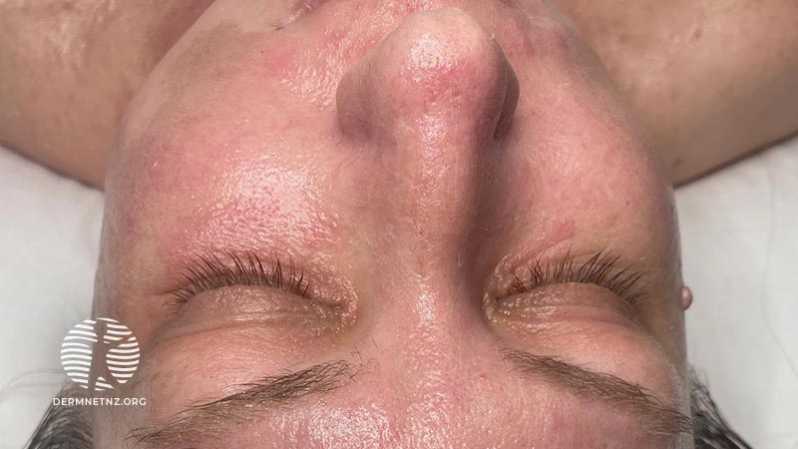DermNet provides Google Translate, a free machine translation service. Note that this may not provide an exact translation in all languages
Erythema and itching of the upper body
Last reviewed: September 2023
Author(s): Noelani Ganz, Aesthetician, Skin Studio Arizona, Scottsdale, AZ, USA
Reviewing dermatologist: Dr Ian Coulson (2023). Edited by the DermNet content department
Background
A woman in her late 30s presents with acute erythema and oedema on the face, ears, neck, arms, upper chest, and back. Isolated areas of the skin are weeping due to vigorous scratching.
The itching seems to peak in the late hours of the night and the intensity will wake her from her sleep. She has a past history of asthma.
What is the diagnosis?
The diagnosis is an acute atopic dermatitis (eczema). Further questioning elucidates she had experienced bouts of eczema since childhood.
Although it could easily be recurrent atopic dermatitis, it is important to ask about possible both irritant and contact allergen exposure.
What could be some triggering factors?
This patient associates acute flare ups in adulthood with excessive alcohol use and poor diet.
Other potential triggers for flare ups include irritants such as soaps, harsh washing powders or laundry detergents, dusty environments, coarse clothing fibres (eg, wool), and topical allergens such as fragrances, cosmetic products constituents (such as biocides, preservatives and foaming agents), and other airborne allergens (such as plants, epoxy resins and acrylates). Stress may be an exacerbating factor. Rarely light can exacerbate longstanding atopic eczema. All aspects need elucidating in the history.
The underlying cause of atopic dermatitis itself is not fully understood and is proposed to be a complex interplay between environmental and genetic factors.
How can this condition be managed?
Regular moisturisers are cornerstone of atopic dermatitis management. Lifestyle factor modification and avoiding irritants and potential allergens are also important.
This patient manages acute flares with the topical steroid clobetasol propionate 0.05% cream, used for 5–10 days at a time to decrease inflammation and manage intense itching. Note that topical steroid use on the face should be minimised and other topical agents such as tacrolimus or pimecrolimus may be considered for facial eczema. Short-term sedating antihistamines may help with nocturnal itch.
In some cases of severe or refractory atopic dermatitis systemic agents or phototherapy may be used. Antibiotics are also sometimes required if there is superimposed infection. It is always advisable to warn those with facial atopic eczema of the problem of superadded infection with herpes simplex, and to avoid situations where this could be acquired.
Related information
Sign up to the newsletter
© 2024 DermNet.
DermNet does not provide an online consultation service. If you have any concerns with your skin or its treatment, see a dermatologist for advice.
